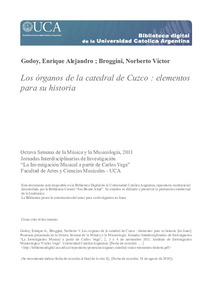Por favor, use este identificador para citar o enlazar este ítem:
https://repositorio.uca.edu.ar/handle/123456789/1097| Título: | Los órganos de la catedral de Cuzco : elementos para su historia | Autor: | Godoy, Enrique Alejandro Broggini, Norberto Víctor |
Otros colaboradores: | Jornadas interdisciplinarias de investigación : La Investigación Musical a partir de Carlos Vega (8ª : 2011 : Buenos Aires) | Palabras clave: | INSTRUMENTOS MUSICALES; PERIODO COLONIAL; CATEDRALES | Fecha de publicación: | 2011 | Editorial: | Universidad Católica Argentina. Facultad de Artes y Ciencias Musicales | Cita: | Godoy, E. A., Broggini, N. V. Los órganos de la catedral de Cuzco : elementos para su historia [en línea]. Ponencia presentada en la Octava Semana de la Música y la Musicología. Jornadas Interdisciplinarias de Investigación “La Investigación Musical a partir de Carlos Vega”, 2, 3 y 4 de noviembre 2011. Instituto de Investigación Musicológica “Carlos Vega”. Universidad Católica Argentina. Disponible en: https://repositorio.uca.edu.ar/handle/123456789/1097 | Resumen: | Resumen: Los dos órganos de la catedral de Cuzco se encuentran entre los instrumentos coloniales más notables del sur del continente. Siguiendo la usanza de las catedrales españolas, están colocados a fachadas opuestas flanqueando la sillería del coro (ubicado en la mitad de la iglesia). Eje de la práctica litúrgicomusical hasta la reforma del Concilio Vaticano II, y tras casi medio siglo de disfuncionamiento, fueron restaurados por el organero francés Jean-François Dupont entre 2004 y 2006. Basándose en inscripciones halladas en ciertos tubos y en las fachadas, la construcción fue atribuida a un tal Lorenzo de Araníbar, que los habría finalizado en 1654 (Epístola) y 1664 (Evangelio). Sin embargo una atenta inspección visual descarta que sean obra de un mismo organero, mientras que evidencias documentales indican que el órgano de la Epístola fue fabricado en 1654-55 por Francisco de Rojas y Antonio Cabezas a imagen y semejanza del órgano del Evangelio, edificado anteriormente. Asimismo se observan modificaciones posteriores con el objeto de “modernizar” la registración a través de nuevos registros partidos. Apoyados por el panorama evolutivo del órgano andino durante los siglos XVI al XVIII, intentaremos esclarecer las circunstancias de su construcción y sucesivas intervenciones. Abstract: The two Cuzco Cathedral organs are among the most noteworthy colonial instruments in the South of the continent. Like in Spanish cathedrals, they are placed in opposite façades beside the choir chairs – placed in the middle of the church. They were the core of the musical liturgical practice until the Second Vatican Council. Almost fifty years of dysfunction passed until, between 2004 and 2006 they were restored by Jean-François Dupont, the French organ builder. Based upon inscriptions found in some pipes and in the façades, they are thought to have been built by a man called Lorenzo de Araníbar, who may have finished the Epistle organ by 1654 and the Gospel organ by 1664. A closer look, however, shows they were not built by the same organ maker, and documents reveal that the Epistle organ was built in 1654-55 by Francisco de Rojas and Antonio Cabezas after the Gospel organ, built before. Furthermore, they were later modified on several occasions with the purpose of modernizing the registration by means of new divided stops. Based on the evolution of the Andean organ from the sixteenth to the eighteenth centuries we will try to clarify the subject of their building and successive modifications. |
Cobertura Espacial: | CUZCO | URI: | https://repositorio.uca.edu.ar/handle/123456789/1097 | Disciplina: | MUSICA | Derechos: | Acceso Abierto | Fuente: | Jornadas interdisciplinarias de investigación. (8ª : 2011 : Buenos Aires) |
| Aparece en las colecciones: | JII 2011 8a. |
Ficheros en este ítem:
| Fichero | Descripción | Tamaño | Formato | |
|---|---|---|---|---|
| organos-catedral-cuzco-elementos-historia.pdf | 223,75 kB | Adobe PDF |  Visualizar/Abrir |
Visualizaciones de página(s)
858
comprobado en 02-sep-2025
Descarga(s)
1.067
comprobado en 02-sep-2025
Google ScholarTM
Ver en Google Scholar
Este ítem está sujeto a una Licencia Creative Commons

